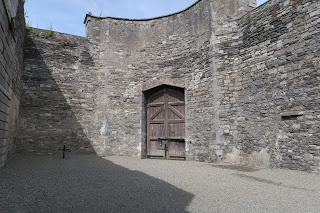It was built in 1796 and called the “New Gaol” as it was replacing an old prison. Originally, public hangings took place at the front of the prison and then in 1891 a small hanging cell was built inside the prison.
The original entrance to Kilmainham Gaol, with Five Snakes in Chains above the entrance
The was no segregation of prisoners; men, women and children were incarcerated up to 5 in each cell, with only a single candle for light and heat. Most of their time was spent in the cold and the dark, and each candle had to last for two weeks. Its cells were roughly 28 square metres. Children were sometimes arrested for petty theft, the youngest said to be a seven year old child, while many of the adult prisoners were transported to Australia.
The spectacular East Wing, providing an extra ninety-six cells, was built in 1861. It was typical of the Victorian belief that prison architecture was crucial to the reform of inmates.
Mural of a Madonna painted by Grace Gifford Plunkett while she was held during the Civil War
In 1910 the Gaol closed as a convict prison and was handed over to the (British) Army who used it as a military detention centre.
On Easter Monday, 1916, groups of the Irish Volunteers and the Irish Citizen Army seized strategic buildings in Dublin and declared an Irish Republic. The Rising lasted a week before the rebels surrendered. Kilmainham Gaol was reopened to house hundreds of men and women for their part. In May of that year, fourteen leaders were executed. During the War of Independence (1919-1921) Kilmainham was now used by the British government to hold captured members of the Irish Republican Army until the truce of 1921. During the Civil War (1922-1924) the Gaol was taken over by the National Army (pro-treaty) and used to house both male and female Republican prisoners. When the Civil War ended, its last prisoner, Eamon de Valera, was released from the Gaol in 1924. After this the Gaol was closed for good.
Cross marking the place of execution of the leaders of the 1916 Rising
Plaque marking the executions of the leaders of the 1916 Rising
Cross marking the place of execution of James Connelly
The courthouse, located beside the Gaol, was opened in 1820 and served as a courthouse until 2008.




















































